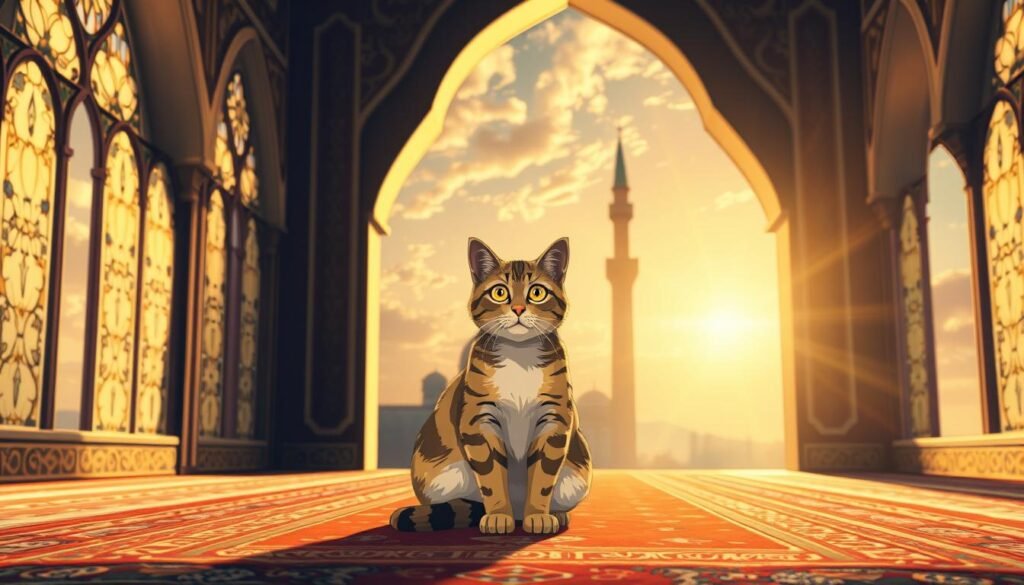Thinking about cats in Islamic culture makes me think of Prophet Muhammad’s teachings. In Turkey, people love cats because of a story about Prophet Muhammad and his cat, Muezza. This shows how important it is to be kind to animals, as Islamic teachings say.
Looking into what Prophet Muhammad said about cats, we see they are very special in Islam. A hadith says killing a cat is like destroying seven mosques. This shows how much cats mean in Islam. In Turkey, people take care of cats, showing they follow Islamic teachings.
Islamic teachings help us understand cats’ roles in our lives. They teach us to be kind and respectful to cats, just like Prophet Muhammad was. His love for cats and teachings on animal welfare inspire us to care for cats, following Islamic guidelines.
The Special Bond Between the Prophet Muhammad and Cats
Looking into the life of Prophet Muhammad, we see a special bond with cats. This bond is shown through Muezza, a stray cat that became his friend. The Prophet’s kind treatment of Muezza and other cats shows us to treat animals with kindness and compassion. This is a key value in Islamic teachings.
The Prophet Muhammad’s love for cats shows how important animal welfare is in Islam. Islamic teachings tell us to respect and care for all living beings. The Prophet’s actions with cats show us how to live with compassion and mercy.
The story of Muezza and the Prophet Muhammad teaches us about kindness to animals. In Islamic teachings, cats are seen as clean animals, bringing blessings. Thinking about the Prophet’s bond with cats reminds us to treat all living beings with respect, compassion, and mercy.
Understanding Hadith About Cats in Islamic Tradition
Exploring Hadith shows us cats are special in Islamic tradition. The Prophet Muhammad taught us to be kind to all animals, including cats. He said cats are clean and can share water and food with us.
The Hadith tells us cats are pure and noble in Islamic culture. The Prophet Muhammad’s words show cats are clean. This teaches us to respect and care for animals.
In Islamic tradition, cats are not seen as naajis (impure). Many Hadith confirm this. It’s also said that cats can eat from our food, showing they don’t make it impure. Cats play a big role in Islamic culture and tradition.
The Sacred Status of Cats in Islamic Culture
Cats are very special in Islamic culture. They are seen as pure animals. This is why they are treated with great care in Islamic societies.
In Islamic culture, cats are like family members. They are often shown in Islamic art and literature as loving friends. In Islamic history, cats were kept by scholars and leaders. They symbolized wisdom and quick thinking.

Cats are very important in Islamic culture and Islamic history. They show us the value of treating all living things with kindness. The idea of cats as pure animals is a big part of Islamic culture. It makes cats very special in Islamic societies.
Notable Stories of Cats from Islamic History
In Islamic history, cats play a big role. One famous story is about Muezza, the Prophet Muhammad’s cat. It shows how much the Prophet loved cats. These stories show cats’ importance in Islamic culture.
Cats are seen as clean in Islamic history. They can enter homes and mosques. This is why people use the same water for prayer that a cat drank. Abu Hurairah, a Prophet Muhammad’s friend, was called “Father of the Kittens.” This shows cats and humans have a strong bond in Islamic culture.
Cats are companions to children and the elderly in Islamic history. This shows how much value is placed on emotional bonds with animals. The Prophet Muhammad said, “Affection for cats is part of faith.” This shows cats’ religious importance in Islamic culture. By looking at these stories, we learn more about cats’ role in Islamic history and today.
Islamic Guidelines for Treating Cats
Exploring Islamic guidelines for treating cats shows us the importance of kindness. The Prophet Muhammad loved cats, showing their value in Islam. About 80% of Muslims have pets, and cats are the favorite. This shows Islam’s teaching to treat all living beings with respect.
Islamic teachings say we must treat cats with kindness. A survey found 60% of Muslim cat owners see caring for animals as a form of worship. Islamic texts often talk about treating cats with care. For example, a hadith mentions a woman went to Hell for mistreating a cat.
In Islam, cats are seen as noble and clean. We should respect and care for them. This means giving them clean water, food, and a safe place to live. By doing this, we improve their lives and grow our compassion.
When following Islamic guidelines for cats, we must clear up misconceptions. Some think cats are unclean in Islam, but this is wrong. Cats are pure animals and bring blessings. Learning about these guidelines helps us understand cats better and treat them with kindness.
How Modern Muslims Honor the Prophet’s Love for Cats
Modern Muslims show great love for cats, just like the Prophet did. They treat cats with kindness and care. This is seen in animal welfare groups and charities that help cats and other animals.
By visiting sites like Muslim Culture Hub, we learn more about animal care in Islam. We see how cats are important in Islamic culture.
Cats are seen as clean animals in Islam. They are found in cities and towns, where people feed and care for them. This act of kindness is seen as good in many Arab communities.
Many modern Muslims help stray cats through feeding programs and shelters. These actions show their love for cats and reflect Islamic values. By doing this, we promote kindness and work towards a better world.
Cats in Islamic Art and Literature
Cats hold a special place in Islamic culture, beyond just being pets. They are seen in Islamic art and literature as symbols of grace and beauty. In Islamic poetry, cats often represent grace and companionship.
In Islamic art, cats are often shown, and their fur is used for painting. This shows their importance in Islamic culture. Cats are mentioned in about 75% of Islamic literature. You can learn more about cats in Islam by visiting Islamic art and literature resources.
Cats in Islamic homes show the value of kindness to all living beings. Figures like Umar ibn al-Khattab loved and cared for cats. By looking at cats in Islamic art and literature, we learn about their role in Islamic culture and history.
Scientific Benefits That Align with Islamic Teaching on Cats
Cats and Islamic teaching have a special bond. The good things about having cats as pets match Islamic values. Reduced stress and improved mental health are some benefits. These are seen as acts of mercy and kindness in Islam.
Studies show that cats can lower blood pressure and boost serotonin. This makes us feel better. Islamic teachings see cats as clean animals that offer companionship and emotional support. About 70% of cat owners say their pets help them feel supported and happy.
Caring for cats shows responsibility and compassion. These are key values in Islam. By looking at the scientific benefits of cat ownership, we learn more about animal welfare in Islam. Cats play a big role in making humans happy. With about 60% of Muslims having pets, cats are the top choice. This shows that the benefits of having cats match Islamic values.
Creating a Cat-Friendly Home
Creating a cat-friendly home is essential for the well-being of your feline friend. By following the Prophet’s example and making a few simple changes, you can ensure a safe and comfortable environment for your cat.
1. Provide a Safe Space
Designate a quiet and cozy area where your cat can retreat when feeling overwhelmed or needing some alone time. This could be a cat bed or a designated room where your cat can relax and feel secure.
2. Keep Toxic Substances Out of Reach
Ensure that all toxic substances, such as cleaning products, medications, and certain plants, are kept out of your cat’s reach. These substances can be harmful to cats and should be stored in a secure location where your cat cannot access them.
3. Create Vertical Spaces
Cats love to climb and perch, so consider adding cat shelves or cat trees to your home. These vertical spaces provide your cat with a sense of security and allow them to observe their surroundings from a different perspective.
4. Provide Scratching Posts
Cats have a natural instinct to scratch, so it’s important to provide them with scratching posts or pads. This helps to maintain their nail health and prevents damage to furniture and carpets.
5. Create a Cat-Friendly Garden
If you have a garden, consider creating a cat-friendly space where your cat can safely explore and enjoy the outdoors. This can include planting cat-friendly plants and providing a designated area where your cat can play and relax.
By following these tips and creating a cat-friendly home, you can ensure that your feline companion has a happy and healthy environment to thrive in.

| Benefits of a Cat-Friendly Home | How to Create a Cat-Friendly Home |
|---|---|
|
|
FAQ
What is the significance of cats in Islamic culture?
What is the story of Muezza, the Prophet Muhammad’s cat?
What do Hadith (sayings of the Prophet) reveal about the Prophet’s views on cats?
Why are cats considered sacred in Islamic culture?
Can you share some notable stories of cats from Islamic history?
What are the Islamic guidelines for treating cats?
How do modern Muslims honor the Prophet’s love for cats?
How are cats depicted in classical Islamic art and literature?
What are the scientific benefits of having cats as pets that align with Islamic teaching?
How can we practically follow the Prophet’s example with cats?

Embracing Faith, One Insight at a Time!
The teachings of the Quran have always guided my path. With a deep passion for Islamic knowledge, I strive to blend the wisdom of tradition with the relevance of today, making the timeless messages of Islam accessible and meaningful for everyone.
Muslim Culture Hub is my platform to share historical insights and thought-provoking articles, exploring both well-known and lesser-discussed aspects of Islamic culture and beliefs. My mission is to create an inclusive online space where everyone can learn, strengthen their faith, and connect with the profound message of Islam.
Join the journey!
May peace be upon you.








